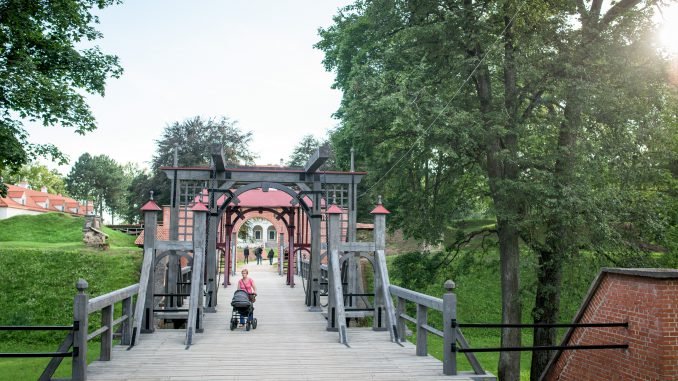
A ducal city
Biržai is an ancient Lithuanian city that is located between the Apaščia and Agluona rivers as well as between two lakes – Lake Širvėna and Lake Kilučiai. According to linguists, the place name Biržai could be tied with the concepts of “birch trees” (Lith. “beržynas”) or “small forest of birch trees” (Lith. “beržynėlis”). Though other places around Biržai were mentioned in historical sources starting in the 14th century, the earliest document mentioning Biržai is known from the middle of the 15th century. On April 14th, 1455 the ruler of Poland and Lithuania Casimir Jagiellończyk wrote a letter to future Trakai Voivode and Vilnius Castellan Radvila Astikaitis (Radziwiłł Ościkowicz), who was simply addressed “Mr. Radvila Astikaitis” at the name and whose name was later used by his descendents, gave Radvila people as a gift and allowed him to settle them in a plot of land bought by Radvila “in the land of Biržai near the German border.”
Radvila’s son, Vilnius Voivode Mikalojus Radvila (Mikołaj Krzysztof Radziwiłł) and his nephew, Vilnius Castellan Jurgis Radvila (Jerzy Radziwiłł). Mikalojus Radvila expanded the lands of Biržai in the direction of the GDL’s northern border along the River Nemunėlis. Next to the Radvilas’ Biržai manor estate, they also established the settlement of Biržai. In 1520 while dividing up the land with his brothers, there were 20 town podymne (yards) that were counted in Biržai that Jurgis Radvila received, while in 1528-1530 there were already 63. However, nothing is known about fair or market privileges for the small town during the early period of its development. The rule of Vilnius voivode Mikalojus Radvila Rudasis (Mikołaj Radziwiłł Rudy) must have looked favourably toward the development of the town, just as he did for the development of all the possessions of Biržai. It was no coincidence that Mikalojus Radvila Rudasis chose the names of Biržai and Dubingiai for his royal titulary he received in 1547. Both possessions were the primary as well as the largest holdings of his native holdings. What’s more, Biržai was close to Livonia. It was no coincidence that he visited this place a number of times. He was there for longer or shorter periods in 1552, 1553, 1556, 1557, 1561 and 1567.
The importance of this place to the duke was illustrated by the events of 1557, when he ordered the vicegerent of Biržai, Petras Oberskis, to ready the manor estate together with the town for Prince Albert of Prussia, who was coming on a visit. In a letter addressed to Radvila from June 1567, Sigismund Augustus wrote: “to the main Biržai.” Apparently, he had in mind the centre of the possession – Biržai Manor and the town nearby.
The town was favourably affected by the Valak Reform carried out in Biržai by Radvila Rudasis in 1563-1567. The town was most like reconstructed, and perhaps it was at that time buildings began to be built according to an orderly designed layout.
The father of Biržai’s self-rule
It was Rudasis’ son, Livonian war hero Kristupas Radvila Perkūnas (Krzysztof Radziwiłł Piorun), who contributed the most to the town. Starting in 1571 while his father was still alive, he began overseeing the issues of the Duchy of Biržai, with its centre in Biržai.
Starting in the 1580s, he began focusing particular attention on the town. The city and castle was to become the main residence of his branch of the Radvilas. He strove to secure various kinds of exemptions and self-rule rights for the town, but it was not easy. His correspondence with the faithful chancellor of the GDL, noble Leon Sapieha, shows that Radvila’s attempts to receive privileges started in 1586. He asked to have Biržai released from paying some kinds of taxes to the state treasury, as it was near the border with Livonia and had experienced great losses in the second half of the 16th century. However, the ruler despite the requests of many noble clients did not approve an exemption for paying customs for Biržai. At the beginning of January in 1589 Sigismund Vasa, who was the ruler of the Commonwealth, after discussions once again with the Podlaskie castellon and Leon Sapieha, agreed to exempt the city of Biržai from paying taxes for 15 years. They wanted to receive the privilege right away, however beforehand they had to do the most important thing – approve the Magdeburg laws. What’s more, Kristupas Radvila had to decide upon a coat-of-arms for the city and selection of dates for the market and fair. This was all decided upon in January and February of 1589.
Kristupas Radvila Perkūnas procured Magdeburg rights, a coat-of-arms and a seal for Biržai from Sigismund Vasa on March 9th, 1589. The original privilege is currently kept in the Library of the Polish Academy of Sciences in Krakow. It is stated in the privilege that the noble wanted to foster and defend his homeland, that he would build a “castle and city of stone and fired bricks.” This is why no agricultural buildings were to be built in the city, and the roofs of the houses were to be covered with shingles. Later Radvila family members also were involved in making Biržai beautiful. Kristupas Radvila Perkūnas’ son, Kristupas II Radvila (Krzysztof Radziwiłł II), demanded that the city be taken care of in a way that it would look good, and if the city dwellers would refuse to build facades on houses facing the street, then they would have to leave the city. In the privilege from 1589, the ruler emphasized the importance of the city of Biržai in protecting the trade route from Vilnius to Riga. Merchants from that time on have to go exclusively through Biržai on the above-mentioned route.
Golden age of Biržai
There were plans to establish a city magistracy and give free city dwellers the right to decide court cases themselves. They were to be examined by functionaries chosen by city burghers: the voigt, burgomasters, councillors, benchers and a clerk. The city’s administrative and legal power was concentrated in the hands of the voigt, however it was the owners of the duchy that dealt with the appeals. It was allowed to organise markets on Thursdays and Sundays, and fairs two times a year (which lasted for two weeks). It was allowed to sell goods without customs and taxes during the fairs. City burghers were freed from some taxes for a longer period, except from the tax for the city treasury. A coat-of-arms was approved: “We give for sealing the city documents and acta, and present the coat-of-arms or public sign – a white flag and a black eagle in its centre – to the town of Biržai. It is precisely this coat-of-arms or sign that we want to have in this city for eternity.”
The rights of self-rule bestowed upon Biržai had great meaning for it. The city grew quickly, and guilds and trades expanded. The city of Biržai became an important and strategic point on the northern border of the GDL. Biržai prospered from the time it received their Magdeburg privilege until the middle of the 17th century.
Bibliography:
Biržų istorijos apybraižos, sud. A. Seibutis, Vilnius, 2006.
